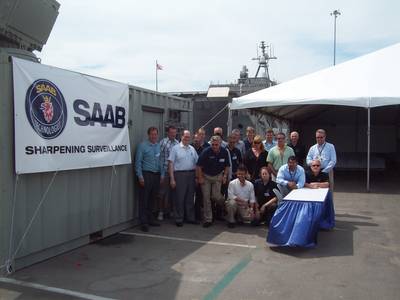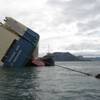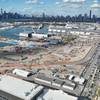Participants at workshop make multiple radar contacts
Sea Giraffe Radar Users Meet in SD
Naval radar experts met in San Diego to share their expertise and experiences with the operation and support of the Saab Sea Giraffe naval surveillance radar. The workshop enabled the participants to make contacts and develop working relationships with other naval experts involved with the operation and support of the Swedish-made system, and create a clearer picture of the current state of the radar and its development.
The Sea Giraffe search radar is been installed on surface combatants, including frigates, corvettes, patrol boats, and the littoral combat ship, and is in service or selected for installation with 12 navies around the world.
Capt. Bo Wallander, RSwN (Ret.), explained the evolution of the Giraffe Land Radar and Sea Giraffe naval surveillance radar, and the models and various improvement that have brought about the current Sea Giraffe AMB. Wallander then laid out the company’s vision regarding the next generation of developments. Wallander said navies have different requirements. For example, he pointed out Sweden has a unique—indeed extreme littoral—operating environment with a long coastlines, thousands of islands, fog, rocks and civilian traffic on the Baltic Sea. But, he said, there are some very similar needs they all share. “We all think about the sensor-to-shooter kill chain solution.”
Although most observers will agree upon the importance and dependednce upon radar for naval and maritime opeerations, Wallander said radars and the relationship to other systems are often misunderstood. ”Radar always gets blamed, even if there is another problem,” he said.
The ability to have minimum reaction time between detection and engagement is critical, he said.
While there is a desire for more capabilities, reliability and affordability are still very important customer considerations, Wallander said.
”There is a high degree of interest in Saab’s Radar “road map” for future naval radar product development, such S Band,” said Capt. Jon Kaufmann, USN (Ret.), responsible for naval domain programs for Saab North America.
Kaufmann said the forum was intended to accomplish three goals. “We want our customers to hear from us; and we want to hear from them. Just as important, we want the representatives of the different navies here to talk to each other so they can compare notes and share lessons learned.”
”There was interest in improving troubleshooting procedures, including the software and hardware tools available to support the radar,” said Kaufman. ”We noted interest in having the ERES (Extended Radar Evaluation System) laptop to record radar video for trouble shooting both locally and remotely using distance support. The ERES is currently used by Saab technicians, but the users feel it would useful for them to have this capability as well.”
Ted Ackerstierna, head of naval domain marketing and sales for Saab Electronic Defense Systems in Gothenburg, Sweden, said the importance of the workshop is to improve Saab’s awareness of the user experience and address any shortcomings, which also helps Saab develop further improvements to the system.
Members of the Saab technical staff were present and available to answer questions and respond to problems.
The great advantage of the users' group, from Saab's point of view, is that it gave the Saab engineers a better idea of how the users viewed their radar.
“The users’ practical knowledge and familiarity with systems employed aboard actual naval vessels is of tremendous value to Saab, and to all of the navies that share this system,” Ackerstierna said.
Ackerstierna said it’s important for Saab to learn what features are desired by customers so they can be evaluated for inclusion in future versions of the Sea Giraffe family.
Breakout sessions were held to discuss logistics, maintanence and operations.
The participants conducted a productive two-way dialog on Saab’s spectrum of logistics support options, including analyzing mean time between critical failures, and full Integrated Logistics Support (ILS).
“Our Operational Availability group discussed spare part availability and particullary the time to get a spare part, said Jörgen Andersson, title. ”We all agreed that this is essential and can drive the requirments and needs for spares on-board.”
”We gave the customers a lot of useful information in a broad spectrum,” Andersson said.
Author and naval analyst Dr. Norman Friedman delivered the opening day keynote address on current trends in naval radars, sensors and combat management systems. “There seemed to be broad agreement with Dr Friedman’s thesis that near term radar advances would be made primarily using software modifications and upgrades rather than hardware, such as new antennas,” Kaufmann said.
“Often those who develop a product or system do not realize its full potential,” Friedman said. “I left the meeting feeling that the radar can do a lot more than Saab engineers realized it could, particularly in the area of radar deception.
Naval radar development is somewhat dependent on computer processing power. Friedman said computing power has progressed steadily, a phenomenon called “Moore’s Law.”
Friedman said Moore’s Law is driven by economics. ”If there isn’t a lot of money in faster chips, then it comes to a screeching halt.”
Friedman also noted that where before different radars were known to emit at certiain frequencies and pulsewidths and repetition rates, today radars employ software to operate in ”multipurpose/multimode just about all the time.”
Changing these parametres means a radar can emulate something else, making it harder to identify and counter. ” Combat management and radar management becomes the same problem.”
He also discussed how radars can be moderized without a complete replacement of hardware. ”You don’t change the antenna, you change what it produces.”
Sharing experience in employing the radar, participants from the navies suggested improvements such as modifications tothe radar control panel, specifically to allow more flexibility in start-up and shut down procedures, or a simplifying the different pull-down menues available to the operator.
“A U.S. radar engineer explained why it was important that the enormous versatility of the radar be reduced (for the operator) so that he could set it up using only one button,” Friedman said. “The operators in turn got a much better idea of the potential the radar offered. Moreover, everyone present got a better idea of the differing operating practices of the navies involved. I would hope that inspired those from the different navies to think about what they could do with this radar that they had not been able to do with earlier, less capable or less flexible ones.”
While each of the navies represented at the event have vastly different missions, operational concepts and operating environments, there seemed to be a general agreement that ”multi-mission capability, such as offered by Sea Giraffe, was the best solution.
Each navy gave a presentation on their mission and employment of the Sea Giraffe radar. Breakout sessions covered new capabilities; creating a supply chain support taskforce; and improving documentation for the logistics reporting system.
“It is productive to come together to talk navy-to-navy to discuss operational and technical issues,” said Cmdr. Bo Berg, head of naval procurement for the Swedish Navy.
(As publsihed in the November 2012 edition of Maritime Reporter - www.marinelink.com)















